Colorado-based artist Emma Longcope, 25, sees art and journaling as a way to slow down and better appreciate her surroundings on the skintrack. And although she considers her art a hobby, Longcope works to bring her artistic side to her day job as the content coordinator for the American Alpine Club by illustrating infographics and other nature-inspired materials. We chatted with Longcope to learn more about why she likes to paint the public lands she works hard to protect.
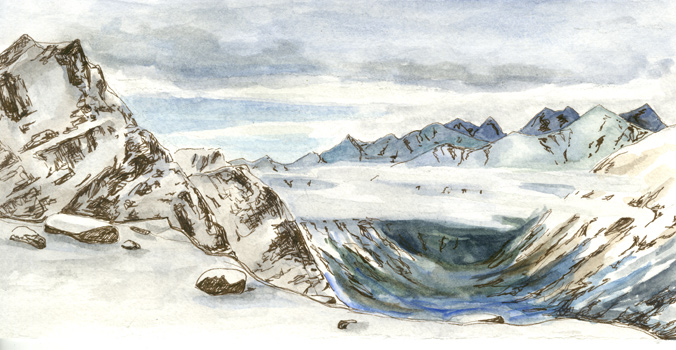
Image: Snowbird Glacier, Alaska
Backcountry Magazine: What’s your artistic background?
Emma Longcope: When I was young, my family went on lots of little day hikes; my mom would always bring watercolor pencils to the top of the mountain for our lunch break, and I’ve just kept up the habit. I love keeping track of things through journaling; it makes hikes so much more fun—to take those breaks and take a breath and look at what’s around you.
BCM: How does your relationship with the backcountry influence your pieces? Have specific places led you to do specific things?
EL: I don’t know if painting has influenced my skiing more or if skiing has influenced my painting more. Taking a moment when I’m skiing affects the way in which I travel in the backcountry. I have so many friends who are light and fast, and I’m not. I enjoy stopping and taking in the view and painting it; I think that’s really worth it.
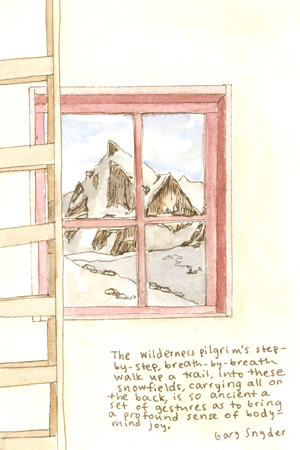
Image: A view from Snowbird Hut, Talkeetna Mountains, Alaska
BCM: What is your process for creating pieces?
EL: I mostly do watercolor sketches. That’s usually just plein-air painting—looking at the view and painting it in a sketchbook—which is what I’m most comfortable with. I always paint more when I’m traveling, because I’m super conscientious about the view and everything passing by.
Last spring, my boyfriend and I did the Bomber Traverse in the Talkeetna Mountains. It was a long slog, our packs were already heavy and I insisted on bringing all my art supplies. My boyfriend looked at me like, “Are you kidding me?” But I was really glad I brought everything. We ended up experiencing bad conditions and it’s the perfect thing to do in a hut while you wait out storms.
I believe in applying what’s around me and finding a purpose for things that aren’t otherwise going to be used. I’m doing more mountain embroidery with fabric that would otherwise be thrown away. If I had really nice materials and a routine that I went through every single time I created a textile piece, I would get nervous about how good something is, but because of the material I pick, I get to play around; I’m just wingin’ it.
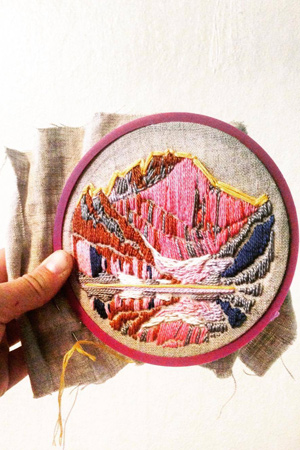
Image: Needlepoint of Longs Peak
BCM: How does your work change based on your surroundings?
EL: When I’m on the road, I feel like I need to document things and slow down. I do more work when I’m off the grid or alone—work I’m a lot happier with than when I’m connected to the daily rhythms of our world.
In Winter 2016, I was an AmeriCorps Member at the Teton Science Schools (TSS) in Jackson Hole, Wyo. where I developed environmental education programs for middle school-aged kids. After a semester living in a small TSS dorm room, I moved into my car while guiding climbing and rafting trips in the Tetons. The logistics of a tiny space made painting difficult, so during that time I primarily used a notebook and a mini watercolor set. Now that I’m in back in an apartment, I have a box for extra fabrics and my sewing machine, so that space gives me more freedom to play around.
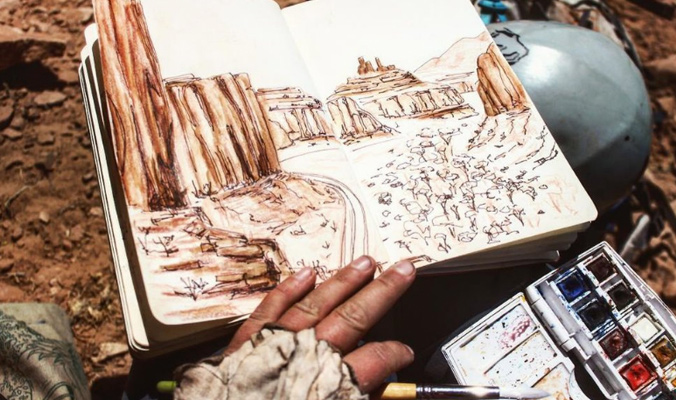
Image: Watercolor journal, Moab, Utah.
BCM: Has there been one backcountry trip where you’ve been really inspired?
EL: That trip in the Talkeetna Mountains in Alaska last spring was really inspiring. I hadn’t done a winter trip to Alaska before and we spent a week on a glacier and got the full spectrum of Alaskan weather. We got there and there was a really thick crust on top of facets—just not fun to ski. On our second or third day, a big storm blew in and everything was covered in the deepest powder I’d ever seen, but it was also a whiteout and super unstable; we ended up with some time in the hut to make art.
The scale of things is so different in Alaska. That’s cliché, but I think everyone that goes to Alaska and comes back says that. Some of the glaciers are receding really rapidly, so I wanted to document it, because not only was I moving through that landscape quickly, I was also on a short trip and wanted to take it all in and remember it. That landscape is not going to be that way for much longer.
I’ve had some really great hut trips where I’ve painted things I’ve skied afterwards. It’s a fun way to keep track of what backcountry lines I’ve skied. Many times I’ll go on a hut trip and lap a random zone and want to remember what I did, so I draw a little diagram.
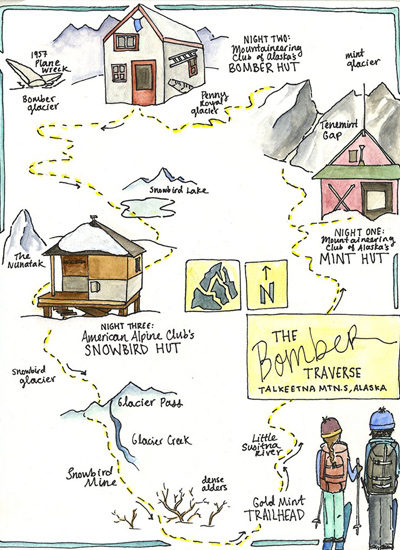
Image: Bomber Traverse route, Talkeetna Mountains, Alaska
BCM: Where do you see your art going in the future?
EL: I try to keep art as a hobby, because I want to keep it fun. One thing I’ve really liked is donating time and art to causes that I care about. I want to keep making art not just to produce pieces, but also to raise awareness for causes I’m passionate about. Most of my recreating happens on public lands, and creating art that inspires a connection to more threatened areas is where my energy is directed right now. I want to go deeper into capturing the feeling of being connected to these places that are fleeting.
—
To view more of her art, visit emmalongcope.squarespace.com.










Related posts:
Skintrack Sketches: Mimi Kvinge looks to balance authentic artistic identity and brand
Skintrack Sketches: Lori LaBissoniere finds her inspiration in the Pacific Northwest's remote landsc…
Skintrack Sketches: Vermont artist Jess Graham speaks to her love of lines in painting and snowboard…
Skintrack Sketches: Artist Lindsay Dew counts on memory to create mountainscapes